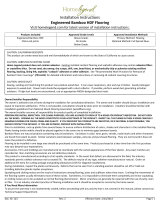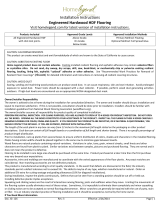
Installation Instructions
Engineered Bamboo HDF Flooring
For Assistance, Call: 1-877-630-1800
Homedepot.com/homedecorators
Products Description
Engineered Bamboo HDF
Click-Lock joints
Grade Levels
Above Grade
On Grade
Below Grade
Installation Methods
Floating Model # HL641H
HOMEDEPOT.COM/HOMEDECORATORS
Please contact 1-877-630-1800 for further assistance.
WARNING: This product can expose you to formaldehyde gas which is known to the State of California to cause cancer. For more information, go to www.P65Warnings.ca.gov.
CAUTION: ASBESTOS IN EXISTING FLOOR:
of Resilient Floor Coverings” (rfci.com) for detailed information and instructions on removing all resilient covering structures.
WARNING: Drilling, sawing, sanding or machining wood products can expose you to wood dust, a substance known to the State of California to cause cancer. Avoid inhaling wood dust or use a dust mask or other safeguards for
personal protection. For more information go to www.P65Warnings.ca.gov/wood.
Safety and Health Precautions
Power tools can be dangerous. Operate in strict accordance to manufacturer’s operating instructions and safety precautions. Unsafe and improper use can cause serious injuries. Avoid inhalation and exposures to wood dust by
mechanical means and by wearing personal protective equipment. Wear appropriate personal protective equipment (PPE) which includes NIOSH or OSHA approve dust masks, safety goggles and work gloves.
Warranty
the stated warranty from the date of purchase. Contact our Customer Service Team at 800-986-3460 to request a written copy which provides detailed terms of coverage and limitations.
Pre-Installation
OWNER/INSTALLER RESPONSIBILITY
The owner is advised to be at home during the installation for consultation/direction. The owner and installer
should discuss installation and layout to maximize satisfaction. If this is not possible, consultation should be
done prior to installation. Installers should be familiar with installation guidelines from National Wood Flooring
installation.
PERFORM PRE-INSTALL INSPECTION. FOR CLAIMS PURPOSES, YOU ARE ALLOWED TO OPEN UP TO 4 BOXES FOR
PRODUCT INSPECTION. DO NOT OPEN ALL THE BOXES. OPENING ALL THE BOXES CONSTITUTES YOUR ACCEPTANCE
OF THE PRODUCT. INSPECT ALL THE PLANKS IN THESE 4 BOXES CAREFULLY. EXAMINE FLOORING FOR COLOR,
FINISH AND QUALITY. IF YOU DISCOVER THAT PRODUCTS ARE DEFECTIVE, OR IF MATERIAL IS QUESTIONABLE, YOU
SHOULD CONTACT THE RETAILER. IF YOU ARE SATISFIED, PROCEED WITH INSTALLATION.
Prior to installation, rack up planks from several boxes to ensure uniform distribution of colors, shades and
minimize gaps between boards.
other characteristics. They are normal and it does not mean the product is defective.
Any exact matches are coincidental. Non-matching accessories are not defective products.
This product is manufactured according to strict quality standards. In the event that defects are discovered in
installations) should be factored in for cutting wastage and grading allowances.
During installation, inspect the planks continuously. Defects that can be seen from a standing position should be
cut off or held out. Installing defective planks implies acceptance.
impossible to eliminate them completely and minor squeaking or clicking noises are to be accepted as normal
To assure the warranty is not inadvertently voided, before proceeding with any activity that is not covered in this
manual, please contact our Customer Support Team at 800-986-3460.
ACCLIMATION AND IN-SERVICE CONDITIONS
NOTE: To obtain accurate moisture content readings, one must use a moisture meter designed for use with
dimensions (width and length) are stable. For example, the averaged dimensions and moisture content remain
constant for 3 consecutive days. Flooring must acclimate for as long as necessary to reach fully acclimated
stage. Acclimation time varies depending on geographical area, interior climate control and time of the year.
Minimum acclimation time is 72 hours. Open the box and plastic wrap.
sticks) between each layer or cross stack the layers for maximum exposure to ambient conditions. Acclimation
acclimated should be maintained continuously thereafter.
CONCRETE SUBFLOOR REQUIREMENTS
□Have minimum rated strength of 3000 psi.
□Be level to within 1/8 in. in a 6 ft. span or 3/16 in. in a 10 ft. span; no bumps or low spots. High spots can
installation.
□
scrape and sweep away before the installation; no protrusions of nails, debris, metals should remain.
□New concrete slab must cure for at least 60 days. It must have a minimum 10 mil polyethylene sheet
between the ground and the concrete.
□
CONCRETE MOISTURE
Perform tests at locations around exterior doorways, near walls containing plumbing, near foundation walls
and in the center of the room. Minimum sample size is 3 samples per 1000 sq. ft. of area and one test for every
additional 1000 sq. ft. thereafter.
Moisture content should meet one of the following criteria:
□4.5% when tested using Tramex Concrete Moisture Encounter.
□Less than 3 pounds per 1000 sq. ft. per 24 hours when using Calcium Chloride test (ASTM F 1869).
□75% when using Relative Humidity Testing (ASTM F-2170).
NOTE: Concrete moisture content may be acceptable the time of the test. These tests do not guarantee a
perpetual “dry” concrete slab. The concrete slab moisture content can vary at other times of the year. We are
LIGHT WEIGHT CONCRETE
Light weight concrete is concrete with a rated strength that is less than 3000 psi. Perform a quick check by
drawing a nail across the top; if it leaves an indentation, it is probably light concrete.
For glue-down applications, the concrete must possess shear strength greater than the glue. If concrete rated psi
is unknown, contact the adhesive manufacturer for guidance.
□
□
nails; no signs of ply de-lamination or other damages. Repair all shortcomings before installation.
□
ft. span or 3/16 in. in 10 ft. Test for moisture using a reliable moisture meter. Perform tests at locations
around exterior doorways, near foundation walls, near walls containing plumbing lines and in the center of
a circular saw. Do not cut in expansion space on tongue and groove panels.
PARTICLE BOARD OR FIBER BOARD
EXISTING FLOORS
adhesive failure and fastener failure. Contact the adhesive and fastener manufacturers respectively for their
JOB SITE CONDITION
Prior to installation, the installer must ensure that at the time of installation, the job site conditions including
or poor site conditions.
STORAGE AND CONDITIONS
environmentally controlled site in which it is expected to perform. Flooring stored on a concrete slab should be
elevated at least 4 in. to allow air circulation under cartons.
EXISTING HOME
An existing home should have a consistent room temperature of 60°F-80°F and relative humidity (RH) of 35%-
periodically.
NEW CONSTRUCTION OR REMODEL
days preceding installation and should be maintained during and after installation. If it is not possible for
the permanent heating and/or air conditioning system to be operating before, during and after installation,
can enable the installation to proceed until the permanent heating and/or air conditioning system is fully
operational. Your job site should have a consistent temperature of 60°F-80°F and relative humidity (RH) of 35%-
55% which should be maintained continuously thereafter.
BASEMENTS AND CRAWL SPACES
Concrete slab or ground must be dry. The ground in the crawl spaces must be completely covered using 6 mil
black polyethylene. Crawl space clearance between the earth and underside of joists should be no less than
18 in. and the perimeter vent area should be equal to 1.5% of the total square footage of the crawl space or as
mandated by code.
RADIANT HEATED SUBFLOOR
than 84°F. Decrease temperature before installation. Increase temperature gradually after installation. Glue
MOISTURE BARRIER AND MOISTURE RETARDER
CONCRETE SUBFLOOR
edge seams and tape it together. Extend moisture barrier up to the wall about 1 in. high.
For direct glue installation, use a moisture barrier if moisture levels exceed the requirement (see Concrete
Moisture section).
WOOD SUBFLOOR
Use asphalt-saturated kraft paper or #15 or #30 felt that meets ASTM Standard D4869 or UU-B-790, Grade
D. Overlap along the edge seams 2 in.- 4 in. wide. This retards moisture movement from below. Extend the
SOUND CONTROL UNDERLAYMENT
Check with the sound control manufacturer for application guidelines. Generally, the less compressive
underlayment is preferred.
EXPANSION GAP
obstructions. Do not place permanently mounted structures such as kitchen counters/cabinets on the installed
TRANSITION MOLDING
length or width; wall openings with or without a door.
NOTE:
TOOLS
Tape measure • Moisture meter (wood, concrete or both) • Chalk line & chalk • Hammer • Electric power saw •
• Straight edge or Spacers • Pry Bar • Mallet • Broom • Color matched wood putty • Tapping block • Pull bar
Additional Supplies for Glue-Down Method: Flooring adhesive • Trowels • Adhesive remover for selected
adhesive • Clean rags • Weight roller • Painters tape
Helpful Pointers
□Make sure your work area is well lit. Good visibility ensures that color is consistent and that visually defective planks are detected and removed.
□
□
CUTTING THE LAST ROW TO WIDTH
□
□
installation
Preparing for Installation
□
□
do not have tongue and groove. There is an upper drop-lock end on one side and a lower-drop lock end on
the other side.
□Lay out several cartons. Randomly rack planks to ensure good color and shade mixture and end joint
spacing. Minimum end stagger is 6 in. Inspect plank quality and grading.
□
use.
□Remove the existing base, shoe molding or threshold carefully. They can be used to cover the 1/2 in.
□Install the underlayment (if used) according to the underlayment manufacture instruction.
Floating Installation
1 INSTALLING THE FIRST ROW
a. When possible, begin installation from the straightest wall.
b.
c. Allow a 1/2 in. expansion gap between the plank and the
walls. Use spacers or board.
d.
from the walls.
e. Place the upper drop-lock end of the second plank on the
lock. Maintain a straight edge along the rows.
f. Continue placing the succeeding planks to complete the
row until you come to the last plank.






